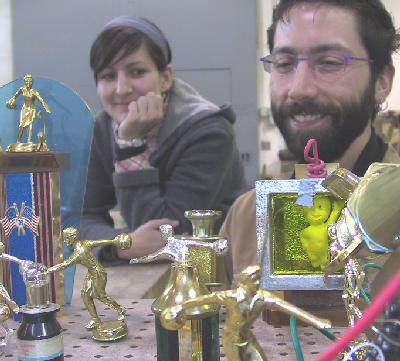March 6, 2003
Students, alumni make for odd ‘Coupling’
Perhaps bowling can bridge a gap between Seattle’s professional artists and its aspiring art students at the UW.
Actually the student-initiated Strangers program in the School of Art has little to do with bowling — at first glance. The program brings student artists together with local professionals to collaborate on artwork. But the process, according to Strangers co-founder Timea Tihanyi, is as important as the product and it’s beneficial for student and professional alike.
Tihanyi’s two-year stint in a cooperative studio, prior to enrolling in the UW’s graduate ceramics program, lacked the discourse and theoretical grounding that can make art within academia so exciting. Yet she knows it’s hard to convey to students the real-world pressures a professional artist is under in order to make ends meet. Pairing the two groups, Tihanyi and co-founder Kris Lyons reasoned, might be mutually beneficial.
“There is a definite split between academia, or art-making in academia, and professional art-making, or being a studio artist in real life,” said Tihanyi. “Here it’s so theoretical. The weirder you make the stuff, the more conceptual, the better. When you go outside, in some ways you’re serving the market. At least, that is probably the easiest way of making it.”
Abraham McClurg and Teresa Huarte, one of the collaborative pairs that contributed pieces to Strangers’ most recent exhibition, Coupling, have clearly rejected any market pressures and landed firmly on the side of the conceptual. The duo contributed three pieces to the show, the most spectacular of which uses portions of women’s bowling trophies to represent Stepford-like drones of the Homeland Security Office.
McClurg said they were inspired on two fronts.
“We went to the Goodwill and once we found a whole shelf of women’s bowling trophies — and there were more women’s bowling trophies than any other single type of trophy there — that, in and of itself, was enough to make us want to do something with women’s bowling trophies.”
And using the trophies for some sort of commentary on the hysteria surrounding a possible war with Iraq and the so-called war on terrorism was a natural. The women, McClurg explains, amount to Exhibit A in the artists’ attempt to unravel the mystery of where one’s bowling ball goes after it passes the pins and before it returns for the next frame.
“All these women, dressed in little ’50s, housewife outfits, they’re doing testing on every ball and taking genetic samples from the thumb holes,” McClurg, a recent UW photography graduate, explained, laughing at their fantastic creation. “They’re making sure that everything is safe in America — at least as far as the bowling lanes go. Then they send the balls back and reset the pins.”
McClurg, like each of the professionals who contributed to the Coupling exhibition, is a fairly recent graduate of the UW’s School of Art. Future exhibitions, much like the first Strangers showing last October, will likely include contributions from a broader range of Seattle artists.
Twenty-eight artists applied for the show and 10 — five students and five alumni — were selected to participate. The pairings were announced during a Feb. 1 meeting. The deadline for a completed work was March 1 and the show opened on Tuesday.
“We wanted them to work together long enough that they would get to know each other,” Tihanyi said. “But the idea was to have two people working together, inspiring each other before they got totally tired of one another.”
And while doing so she figured the art students would get a realistic window into the life of a professional artist. Some of the alumni, like McClurg, have other jobs on the side. Their studios, by and large, are under-whelming in comparison to the lavish studios and equipment available for free to students at the UW. That fact hasn’t gone unnoticed by Huarte.
“You can get a false sense of reality and security here,” she said.
Huarte said preparing artwork for the exhibition is a good way to help her transition from a student artist to a professional artist. It’s been a useful collaboration for McClurg too. After recently returning from an extended stay in Italy, McClurg needed Coupling to help him get back into the swing of things.
“I looked at this as a way to jumpstart my brain and jumpstart my practice.”
Tihanyi and Lyons will graduate at the end of the spring quarter, but they expect to see the Strangers program flourish well into the future.
“We know now that the present first-year graduate students expressed a great interest in the program. We are getting inquiries every day. People really want to take over.”
The exhibition, which is supported by a grant from the School of Art and the Graduate School, will run through March 16. The CMA Gallery is located at 4205 Mary Gates Memorial Drive and is open from 9 a.m. to 5 p.m. daily.



